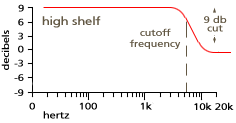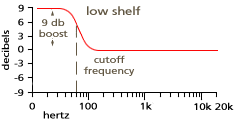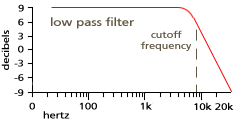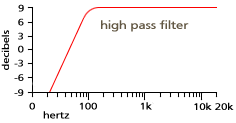| Equalization (Spectral Processing) |
Equalization Types
| Shelf |
| The high shelf cuts or boosts the frequencies above some cutoff frequency by a user determined amount. The following diagram illustrates a high shelf with a cutoff frequency of about 8K and with -9 decibels of attenuation. The cutoff frequency describes the frequency at which 3 decibels of cut or boost is achieved. | The low shelf cuts or boosts frequencies below the cutoff frequency. The diagram below shows the response curve of a low shelf set to boost frequencies below 100 Hertz by 9 dB. |
 |
 |
| The low pass filter is a special case of a high shelf cut where there is maximum attenuation of the high frequencies above the cutoff point. It passes only the lower frequencies. | The high pass filter is the opposite of the low pass. A low shelf cut with maximum attenuation at the cutoff frequency it passes only high frequencies. |
 |
 |
| Band Pass (band limiting) |
| Band pass boosting increases the level of frequencies around some centre frequency over a range determined by the bandwidth of the filter. The following diagram shows the response of a filter with a relatively narrow bandwidth 9 dB boost around the centre frequency. | The diagram below shows a wide bandwidth bandpass cut of 6 dB cut around the centre frequency. |
.gif) |
.gif) |
| Graphic Eq consists of a series of narrow bandwidth filters which can be set to either cut or boost. |
| 1/3 octave | 1/2 octave | parametric
cut, boost, sweep/frequency, Q (bandwidth) |
| All EQ introduces some phase delay into a signal and when used excessively (or repeatedly) can lead to unwanted phase distortion of the resulting mix. | Use EQ judiciously, good microphone technique can help avoid the use of too much equalization. |
| Be aware that EQ affects signal level, a boost in some frequency area has the potential to raise the overall level to distortion or clipping levels while cuts can reduce the impact of a sound, so some level adjustments may need to occur. | Sometimes its better to cut the frequencies around the desired range rather than boosting them directly to avoid distortion or a potentially noisy sound. |